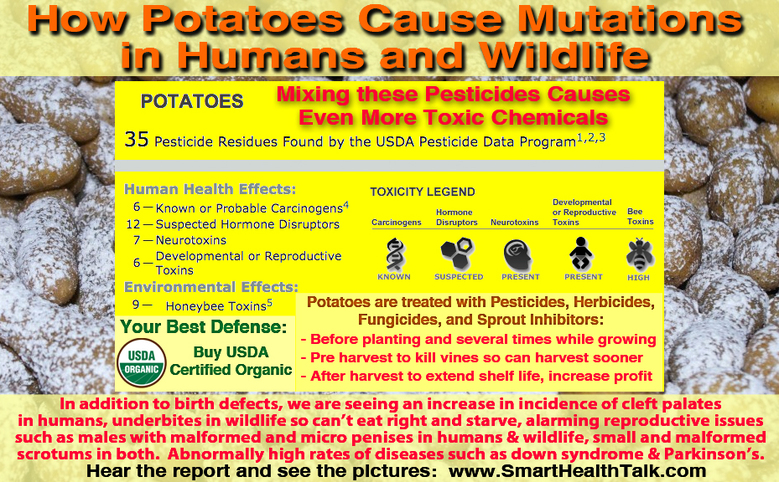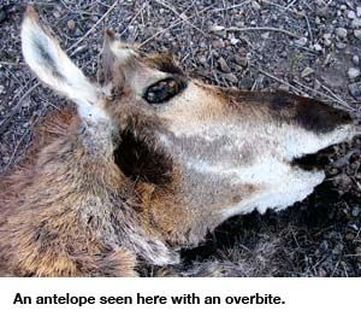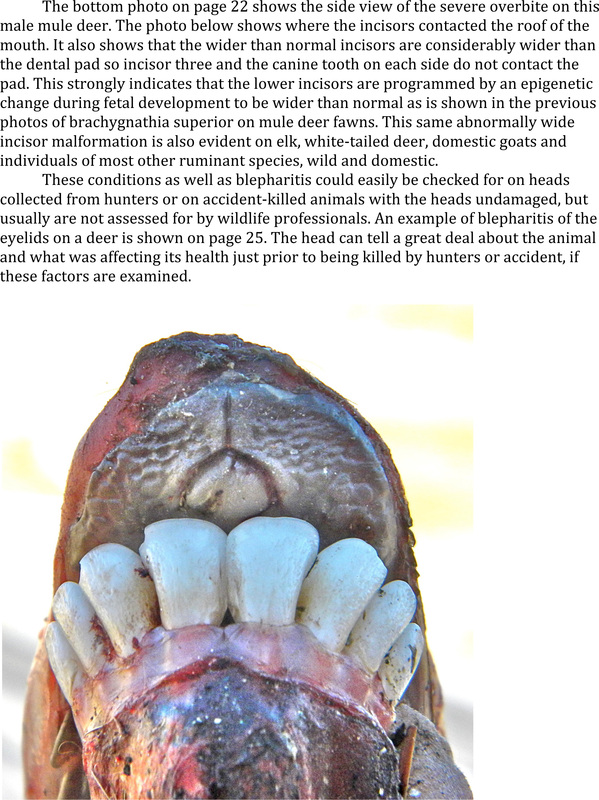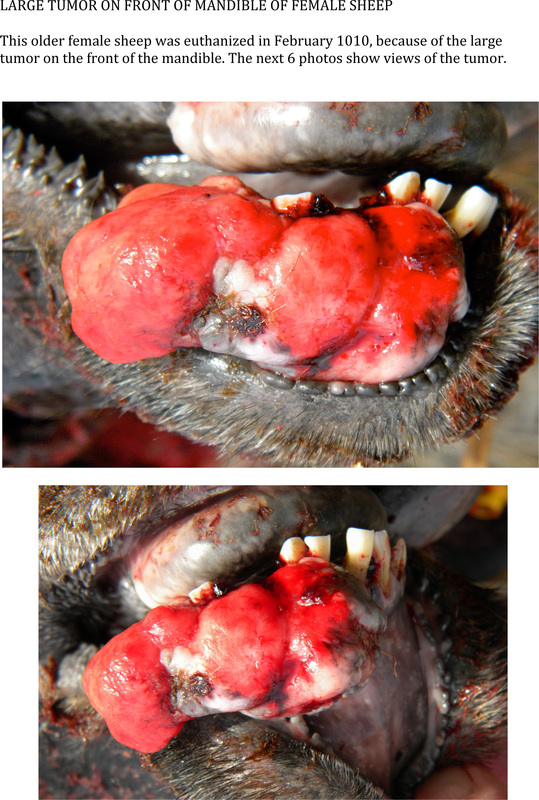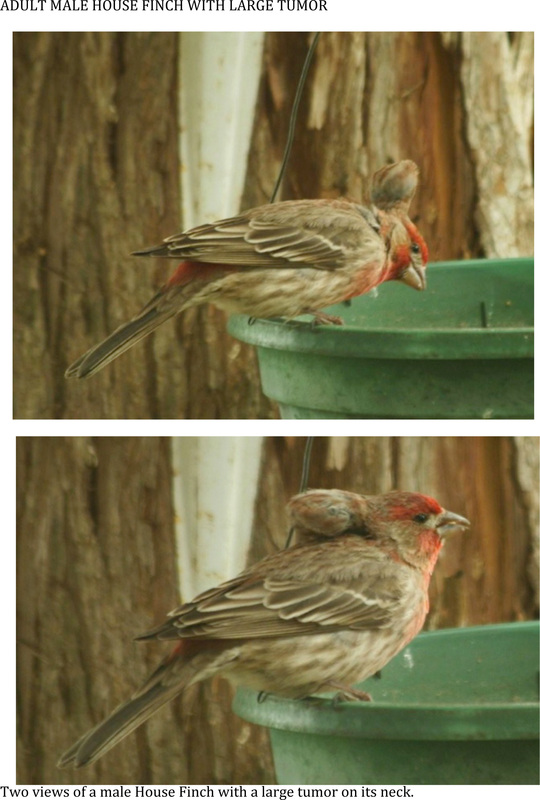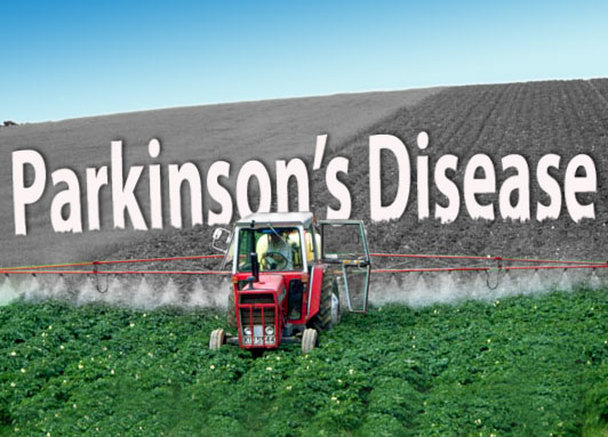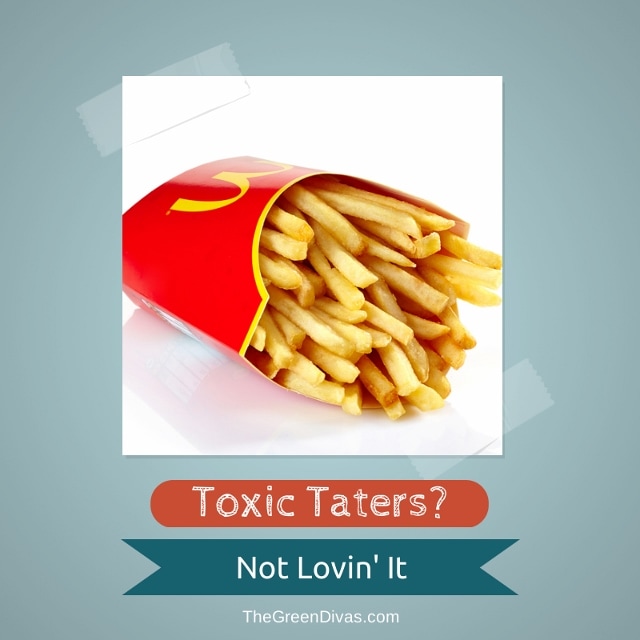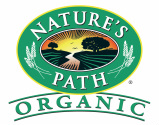|
|
STOP WILDLIFE MUTATION AND PROTECT YOURSELF AND HUMAN BABIES AS WELL BY NOT BUYING
FAST FOOD FRENCH FRIES!
|
Potentially hazardous chemicals concerns voiced in the Bitterroot

It's been a long road for one Ravalli County citizen who has been investigating the effects of potentially hazardous chemicals in the Bitterroot.
But after 20 years and countless independent studies, the Ravalli County Board of Health is drafting a formal letter of concern to the U.S. Environmental Protection Agency.
Judy Hoy is a crusader - and nothing if not persistent. She has been documenting malformations and mutations in the valley's big game animals for two decades.
She says the deformities found can be linked to pesticide and herbicide use and has asked the local government four times send a letter to the EPA
requesting a series of tests to determine the cause.
Hoy says the problem is an obvious one, and action is required. "You can talk to almost anyone now that lives in the valley who has deer in their yard, and they'll say yes they have seen deer with malformations. Well that's pretty bad, because if you can see it on lots of deer, that's a high prevalence!"
The letter of concern will be presented at the next Ravalli County Board of Health Meeting on Jan. 13.
But after 20 years and countless independent studies, the Ravalli County Board of Health is drafting a formal letter of concern to the U.S. Environmental Protection Agency.
Judy Hoy is a crusader - and nothing if not persistent. She has been documenting malformations and mutations in the valley's big game animals for two decades.
She says the deformities found can be linked to pesticide and herbicide use and has asked the local government four times send a letter to the EPA
requesting a series of tests to determine the cause.
Hoy says the problem is an obvious one, and action is required. "You can talk to almost anyone now that lives in the valley who has deer in their yard, and they'll say yes they have seen deer with malformations. Well that's pretty bad, because if you can see it on lots of deer, that's a high prevalence!"
The letter of concern will be presented at the next Ravalli County Board of Health Meeting on Jan. 13.
LISTEN TO OUR GUEST JUDY HOY, A RANGERS WIFE WHO HAS COLLECTED INFORMATION ON WILDLIFE AND HUMAN BABY MUTATIONS FROM POTATO PESTICIDE USE
Judy Hoy has been observing and doing documentation on changes and mutation in wildlife in Montana.
Judy Hoy's husband is a ranger and they run a wildlife refuge for vultures that need meat to eat. Whenever her husband runs across road kill, he throws it in the back of his truck and brings in home for vulture food so keep it from being wasted and save money for the sanctuary.
Judy noticed changes in the wildlife that were disturbing and not normal so she started do autopsies and documenting the mutations, tumors and other abnormalities with photos. She tried to contact the Department of Agriculture and Parks but were not interested in hearing about or looking at her findings.
Here findings were not isolated to wildlife. There were very rare conditions showing up in human babies. Montana is not densely populated and so has a low birth rate. When three babies were born in one weekend with rare chromosomal conditions she knew it was a red flag and tried to alert authorities, but nothing was done.
Judy tested her own front yard for pesticides and found high levels of those pesticides used to grow potatoes for the fast food industry. The companies that sell French fries on a massive level demand that potatoes meet certain specifications and want the potato to be an exact length to look good in the carton and have absolutely no spots or sprouts. This requires extra pesticides and chemicals such as sprout inhibitors and why you can't get conventional potatoes to grow.
SCROLL DOWN TO READ ABOUT TOXIC TATER
GROUP THAT IS FIGHTING BACK!
GROUP THAT IS FIGHTING BACK!
THIS WILDLIFE IS TELLING US AN IMPORTANT MESSAGE ABOUT THE HARM
POTATO PESTICIDES CAN DO TO MAMMALS WHICH INCLUDE HUMANS!
Oh, deer Ravalli County bucks found with startling malformations
By Chad Harder
At first, the deer was just another carcass in her husband’s truck, one of many road-killed animals brought home to nourish the turkey vultures at Judy Hoy’s wildlife rehabilitation facility south of Stevensville.
Knife in hand, Hoy flipped the buck over to slice off his testes. Hoy’s carnivorous birds prefer this particular part of the deer, and hundreds of road-killed males arriving at her facility had faced similar treatment. But as soon as she rolled the dead buck out of the truck, Hoy noticed he had no scrotum. Testes, yes; scrotum, no.
Moving in closer, Hoy saw the deer’s teeth also stuck out oddly and failed to align correctly. The other two road-killed deer in the truck had similar malformations.
“They looked like female deer, but with a penis,” says Hoy of her discovery 12 years ago.
Hoy, 68, has continued documenting a pattern of malformed grazing animals—including elk, goats and horses—ever since. While not a trained scientist, she’s compiled statistics of road-killed deer and other herbivores, and found that Ravalli County’s population is deformed far beyond the expected variance. Specifically, one in four of the 600 white tail bucks she’s examined suffered from genital abnormalities.
After years of having her work largely marginalized by local officials or professionals in the science community—Hoy admits she’s been labeled “crazy” by some—her work recently caught the attention of Diane Henshel, a researcher at the University of Indiana. Henshel is particularly interested in pinpointing the cause of the abnormalities, which are believed to be the result of airborne chemicals sprayed on crops in other states.
“It’s quite clear the abnormalities are real,” says Henshel, “and the abnormal genitalia are not within the normal range of things that might happen just from background
[pollution].”
Henshel studies pollutants and how they affect the development of organisms, primarily in utero, and was interested in scrutinizing Hoy’s research. After an initial visit in 2007, she recruited two graduate students to further the study, and that research continues today.
That’s a long way from where Hoy started in 1996. Her husband, Bob, worked as a game warden for Montana Fish Wildlife and Parks (FWP) at the time and would lug Ravalli County road kill home to feed injured or orphaned carnivores in Hoy’s care. This left Hoy with a large cross section to find and document abnormalities.
“Bob used to pick up a whole pickup load between here and Stevensville,” she says.
Hoy discovered a startling pattern of variances, first in male genitalia, and later in both sexes’ jaw and skull bones. This “prognathism,” or underbite, indicates a disruption in embryonic development, she says.
The culprit, according to Hoy, is likely the fungicide chlorothalonil, which is sprayed on potato farms in Idaho, Oregon and California, and wafts into Montana. Hoy points to a massive increase in the chemical’s use from 1994–1996. Twelve million pounds were sprayed in the United States in 1997, the latest figures available from the U.S. Environmental Protection Agency. Hoy believes that chlorothalonil and its byproducts piggyback on air currents into Montana before being ingested by herbivores.
In 1998 she performed a test to prove it. After placing pans outside before a snowfall, Hoy sent the melt water to a lab in Billings. Hoy says the lab found both chlorothalonil and hexachlorobenzene (a known carcinogen) in the water. According to the EPA, these chemicals have displayed profound effects on regulatory hormones and thyroid function. Hoy is concerned that when combined with other airborne chemicals, the effects on animal health are compounded.
Henshel and Hoy agree that humans are also likely affected. Hoy has assembled numerous charts linking the chemicals to premature births and diabetes in humans, although Henshel was unsuccessful at securing human malformation data from local or state officials.
“I had a hard time finding anyone who would be cooperative by providing human data,” Henshel says. “It’s just hard in Montana.” The Ravalli County Health Department did not return calls seeking comment for this report.
Keeping game animals healthy is serious business in Montana, and FWP says it’s aware of Hoy’s research. In fact, Neil Anderson, the head of the agency’s wildlife laboratory in Bozeman, investigated the malformations two years ago. He determined that no pattern existed, publishing a report recommending against further study by the state.
“We get lots of calls about abnormalities in deer and elk, and they’re pretty well explained in the literature,” says Mike Thompson, an FWP wildlife manager covering western Montana. “I don’t dismiss out of hand what [Hoy] says, it just doesn’t play out at the population level.”
Anderson adds that he respects Hoy’s dedication to the issue, but simply can’t confirm her findings.
“We’ve had a lot of discussions, and I don’t necessarily think she’s nuts,” says Anderson. “I actually kind of admire her passion and her persistence, but I just can’t necessarily agree with her assessment.”
That assessment doesn’t surprise Henshel.
“They don’t like to listen to Judy, and Judy’s right,” she says. “She’s not at all crazy, she’s not a crank, and she should have received her Ph.D. a long time ago.”
While Thompson says he agrees with Anderson’s 2006 report, he also says FWP will look further into white tail deer abnormalities this coming hunting season at the Bonner Check Station.
“We’ve already got their mouths open,” he says. “We can take a look.”
By Chad Harder
At first, the deer was just another carcass in her husband’s truck, one of many road-killed animals brought home to nourish the turkey vultures at Judy Hoy’s wildlife rehabilitation facility south of Stevensville.
Knife in hand, Hoy flipped the buck over to slice off his testes. Hoy’s carnivorous birds prefer this particular part of the deer, and hundreds of road-killed males arriving at her facility had faced similar treatment. But as soon as she rolled the dead buck out of the truck, Hoy noticed he had no scrotum. Testes, yes; scrotum, no.
Moving in closer, Hoy saw the deer’s teeth also stuck out oddly and failed to align correctly. The other two road-killed deer in the truck had similar malformations.
“They looked like female deer, but with a penis,” says Hoy of her discovery 12 years ago.
Hoy, 68, has continued documenting a pattern of malformed grazing animals—including elk, goats and horses—ever since. While not a trained scientist, she’s compiled statistics of road-killed deer and other herbivores, and found that Ravalli County’s population is deformed far beyond the expected variance. Specifically, one in four of the 600 white tail bucks she’s examined suffered from genital abnormalities.
After years of having her work largely marginalized by local officials or professionals in the science community—Hoy admits she’s been labeled “crazy” by some—her work recently caught the attention of Diane Henshel, a researcher at the University of Indiana. Henshel is particularly interested in pinpointing the cause of the abnormalities, which are believed to be the result of airborne chemicals sprayed on crops in other states.
“It’s quite clear the abnormalities are real,” says Henshel, “and the abnormal genitalia are not within the normal range of things that might happen just from background
[pollution].”
Henshel studies pollutants and how they affect the development of organisms, primarily in utero, and was interested in scrutinizing Hoy’s research. After an initial visit in 2007, she recruited two graduate students to further the study, and that research continues today.
That’s a long way from where Hoy started in 1996. Her husband, Bob, worked as a game warden for Montana Fish Wildlife and Parks (FWP) at the time and would lug Ravalli County road kill home to feed injured or orphaned carnivores in Hoy’s care. This left Hoy with a large cross section to find and document abnormalities.
“Bob used to pick up a whole pickup load between here and Stevensville,” she says.
Hoy discovered a startling pattern of variances, first in male genitalia, and later in both sexes’ jaw and skull bones. This “prognathism,” or underbite, indicates a disruption in embryonic development, she says.
The culprit, according to Hoy, is likely the fungicide chlorothalonil, which is sprayed on potato farms in Idaho, Oregon and California, and wafts into Montana. Hoy points to a massive increase in the chemical’s use from 1994–1996. Twelve million pounds were sprayed in the United States in 1997, the latest figures available from the U.S. Environmental Protection Agency. Hoy believes that chlorothalonil and its byproducts piggyback on air currents into Montana before being ingested by herbivores.
In 1998 she performed a test to prove it. After placing pans outside before a snowfall, Hoy sent the melt water to a lab in Billings. Hoy says the lab found both chlorothalonil and hexachlorobenzene (a known carcinogen) in the water. According to the EPA, these chemicals have displayed profound effects on regulatory hormones and thyroid function. Hoy is concerned that when combined with other airborne chemicals, the effects on animal health are compounded.
Henshel and Hoy agree that humans are also likely affected. Hoy has assembled numerous charts linking the chemicals to premature births and diabetes in humans, although Henshel was unsuccessful at securing human malformation data from local or state officials.
“I had a hard time finding anyone who would be cooperative by providing human data,” Henshel says. “It’s just hard in Montana.” The Ravalli County Health Department did not return calls seeking comment for this report.
Keeping game animals healthy is serious business in Montana, and FWP says it’s aware of Hoy’s research. In fact, Neil Anderson, the head of the agency’s wildlife laboratory in Bozeman, investigated the malformations two years ago. He determined that no pattern existed, publishing a report recommending against further study by the state.
“We get lots of calls about abnormalities in deer and elk, and they’re pretty well explained in the literature,” says Mike Thompson, an FWP wildlife manager covering western Montana. “I don’t dismiss out of hand what [Hoy] says, it just doesn’t play out at the population level.”
Anderson adds that he respects Hoy’s dedication to the issue, but simply can’t confirm her findings.
“We’ve had a lot of discussions, and I don’t necessarily think she’s nuts,” says Anderson. “I actually kind of admire her passion and her persistence, but I just can’t necessarily agree with her assessment.”
That assessment doesn’t surprise Henshel.
“They don’t like to listen to Judy, and Judy’s right,” she says. “She’s not at all crazy, she’s not a crank, and she should have received her Ph.D. a long time ago.”
While Thompson says he agrees with Anderson’s 2006 report, he also says FWP will look further into white tail deer abnormalities this coming hunting season at the Bonner Check Station.
“We’ve already got their mouths open,” he says. “We can take a look.”
Click Here to go to the great article on this subject from IntegratedHealthBlog.com
From Prevent Disease:
The Farm Director Won’t Eat: Nonorganic Potatoes
Jeffrey Moyer is the chair of the National Organic Standards Board.
The problem: Root vegetables absorb herbicides, pesticides, and fungicides that wind up in soil.
In the case of potatoes–the nation’s most popular vegetable–they’re treated with fungicides during the growing season, then sprayed with herbicides to kill off the fibrous vines before harvesting. After they’re dug up, the potatoes are treated yet again to prevent them from sprouting. “Try this experiment: Buy a conventional potato in a store, and try to get it to sprout. It won’t,” says Moyer, who is also farm director of the Rodale Institute (also owned by Rodale Inc., the publisher of Prevention). “I’ve talked with potato growers who say point-blank they would never eat the potatoes they sell. They have separate plots where they grow potatoes for themselves without all the chemicals.” [emphasis added]
Only potatoes/sweet potatoes grown pesticide-free (including organic) can grow them. Meanwhile, the numerous treatments to kill pests mean numerous agents of death also pass into your body when you eat the food treated with the industrial chemicals of modern mega-agriculture.
The Farm Director Won’t Eat: Nonorganic Potatoes
Jeffrey Moyer is the chair of the National Organic Standards Board.
The problem: Root vegetables absorb herbicides, pesticides, and fungicides that wind up in soil.
In the case of potatoes–the nation’s most popular vegetable–they’re treated with fungicides during the growing season, then sprayed with herbicides to kill off the fibrous vines before harvesting. After they’re dug up, the potatoes are treated yet again to prevent them from sprouting. “Try this experiment: Buy a conventional potato in a store, and try to get it to sprout. It won’t,” says Moyer, who is also farm director of the Rodale Institute (also owned by Rodale Inc., the publisher of Prevention). “I’ve talked with potato growers who say point-blank they would never eat the potatoes they sell. They have separate plots where they grow potatoes for themselves without all the chemicals.” [emphasis added]
Only potatoes/sweet potatoes grown pesticide-free (including organic) can grow them. Meanwhile, the numerous treatments to kill pests mean numerous agents of death also pass into your body when you eat the food treated with the industrial chemicals of modern mega-agriculture.
Organically grown potatoes require more tender care than potatoes drenched in sprout-killing fungicide. They should be stored in a cool, dark place (a loosely closed paper bag works really well) and used within two to three weeks. Don't refrigerate them; then the starch turns to sugar, making the potato excessively sweet. Cut off any sprouts or green colored portions.
A. THE IMPORTANCE OF THYROID HORMONES IN FETAL DEVELOPMENT.
1. Proper levels of thyroid hormones are needed to direct normal growth of brain cells, nerves, bones, muscles, reproductive organs, eyes, ears, the immune system, especially the thymus, and other organs on a developing mule deer fawn.
2. Thyroid hormones from both the maternal and fetal thyroid glands are like production managers for fetal development. If the production managers are compromised or interfered with in some way, the final product (the fawn) is likely to be flawed in some way.
3. Malformations and other adverse health symptoms in newborns, including mule deer fawns as a result of disrupted thyroid hormones during development, is commonly called Congenital Fetal Hypothyroidism (CFH).
4. Malformations as a result of Congenital Fetal Hypothyroidism are not genetic, the changes are epigenetic.
B. OTHER HORMONES BEING DISRUPTED BY ENVIRONMENTAL TOXINS.
According to multiple studies sex hormones, including aromatase, are being disrupted by a number of environmental toxins. Vitamin D3, actually a hormone is disrupted by some chemicals used for pesticides (umbrella term), as is retinoic acid (Vitamin A). Some hormone disrupting toxins disrupt the normal functions of glutathione, essential for cellular respiration. The disruption of those hormones, which are absolutely necessary for normal fetal development, is likely the cause of the drastic increase in epigenetic changes to fetuses during development in the womb.
C. WHAT DOES EPIGENETIC MEAN?
Epigenetics is the study of changes in gene activity that do not involve alterations to the genetic code. Epigenetic changes can be passed on for one or several generations. The new patterns of gene expression are regulated by cellular material called the epigenome. The prefix, epiM, means above. The epigenome sits on top of the genome and just outside of it. These epigenetic “markers” on the genome tell the genes when to switch on or off and/or dictate the strength of the gene expression. Gene expression in a young animal during its development is influenced by various environmental factors such as nutrition, radiation, chemical exposure and diet of the mother. Epigenetic changes can be passed to the next generation or for several generations, but the DNA of the genes is not thought to be affected. Thus, epigenetic changes to individual organisms represent a biological response to an environmental factor or factors, but do not change the DNA of the organism.
All cell types on one animal – brain cells, muscle cells, nerve cells, keratin cells, bone cells, etc.– contain the exact same DNA. Epigenetic switches silence certain gene sequences and activate others, so that embryonic cells can differentiate. If the switches do not work correctly, the cells may begin to continuously reproduce, resulting in cancer.
Or premature cell death may occur, resulting in failure of organs to develop or function correctly. It takes only the addition of a methyl group, one carbon atom attached to three hydrogen atoms, to change an epigenome. When a methyl group attaches to a specific spot on a gene, it can change the gene’s expression, turning it off or on, lessening its expression or increasing it. Results of such epigenetic changes to developing young can range from deadly to bizarre and sometimes beautiful.
D. THE MOST COMMON EPIGENETIC CHANGES CAUSED BY CONGENITAL FETAL HYPOTHYROIDISM (CFH) ON RUMINANT SPECIES, INCLUDING MULE DEER.
1. Mild to severe Brachygnathia Superior (BS), which is underdevelopment of the bones of the upper face, especially the premaxillary bone. Also called underbite, it is the most common CFH symptom on ruminants, including mule deer.
2. Mandibular Brachygnathia (MB) is the underdevelopment of the lower jaw, resulting in overbite. This does not appear to be as common on ruminants as BS, but has a prevalence of over 5% on mule deer in Montana. Any malformation with a prevalence of over 5% is suppose to be significant.
3. Death just prior to birth or miscarriage sometime during fetal development.
4. Inability to maintain heat and energy, resulting in failure to get up and suckle after being born, resulting in death soon after birth.
5. Umbilical hernias resulting in death sometime after being born.
6. Contracted tendons in leg joints, causing difficulty standing, walking and running, usually resulting in the death of the affected newborn.
7. Limbs or portions of limbs, especially the digits, not developed at all, only partly developed, crooked or otherwise malformed often resulting in death soon after birth.
8. Small eyes and occasionally, problems with sight or total blindness, resulting in death.
9. Disrupted immune system because of underdeveloped or damaged thymus causing newborns to be susceptible to infections and/or parasites, which can cause death.
10. Damage to internal organs, especially the heart, lungs and liver.
11. Enlarged right heart ventricle sometime with dilated vessels on the heart surface.
12. Fluid build up in the lungs causing damage to lung tissue.
13. Disrupted liver function affecting newborn ruminant’s ability to detoxify chemicals and affecting ability to digest milk, resulting in diarrhea, dehydration and often death.
14. Dished face with eyes facing more forward than normal for a ruminant species.
15. Underdeveloped skull bones or rounded skull.
16. Rolled or floppy ears.
17. Underdeveloped male genitalia, including no, short and/or misaligned scrotum and short penis sheath on the external skin.
18. Abnormal pedicle placement and/or abnormal antlers or horns on male ruminants.
19. On live animals, brittle hair and hair loss is a common symptom of severe thyroid hormone disruption.
20. On live animals, the inside of the eyelids (the conjunctiva) should be checked for inflammation. Conjunctiva that is reacting to airborne toxins is red and swollen. The conjunctiva on dead animals should always be checked for inflammation, especially if the animal dies of “natural causes.” Being poisoned by toxins can’t really be considered a natural cause.
E. BRACHYGNATHIA SUPERIOR AND MANDIBULAR BRACHYGNATHIA.
• Brachygnathia Superior is the underdevelopment of the upper facial bones, especially the premaxillary bone forward of the premolars.
• Brachygnathia Superior is commonly called underbite because the lower incisors are forward of the premaxillary pad on ruminants and forward of the upper incisors on other mammals, including humans.
• Mandibular Brachygnathia is the underdevelopment of the lower jaw forward of the premolars and is commonly called overbite.
• Many newborn ruminants, including white tailed deer and mule deer have abnormally shaped, crooked incisors, often wider than normal for the species.
• High rates of ungulates are being born each year with BS in Montana and other western states. These include elk, mule deer, white-tailed deer, pronghorn antelope, big horn sheep, bison and domestic animals such as goats, cattle, horses, sheep, llama and alpaca. A few individuals of some ruminant species are born with MB, but not at nearly as high in prevalence as BS. It is the opposite on humans, with MB and underdeveloped chin presently being much higher in prevalence than underbite, according to dentists consulted.
• BS, MB and malformed lower incisors appear to be caused by disruption of the epigenetic programming directing normal calcium uptake in the facial bones that have growth adversely affected during development.
• CFH symptoms which result in mortality prior to or soon after birth, have been at least partly responsible for the declines in wild ruminant populations, including/especially mule deer, because of non-survival of the young. There are not enough young surviving to be born, or surviving after being born to provide enough mule deer for all the predators, including human hunters and still maintain adequate population levels.
See our 2011 study for discussion of the many factors affecting the ruminant populations and the domino effect the factors have on populations.
This study is on Google. (J.A. Hoy, G.T. Haas, R.D. Hoy and P. Hallock, Observations of Brachygnathia Superior in wild ruminants in Western Montana, USA. (December 2011) Wildlife Biology in Practice.) doi:10.2461/wbp.2011.7.13
1. Proper levels of thyroid hormones are needed to direct normal growth of brain cells, nerves, bones, muscles, reproductive organs, eyes, ears, the immune system, especially the thymus, and other organs on a developing mule deer fawn.
2. Thyroid hormones from both the maternal and fetal thyroid glands are like production managers for fetal development. If the production managers are compromised or interfered with in some way, the final product (the fawn) is likely to be flawed in some way.
3. Malformations and other adverse health symptoms in newborns, including mule deer fawns as a result of disrupted thyroid hormones during development, is commonly called Congenital Fetal Hypothyroidism (CFH).
4. Malformations as a result of Congenital Fetal Hypothyroidism are not genetic, the changes are epigenetic.
B. OTHER HORMONES BEING DISRUPTED BY ENVIRONMENTAL TOXINS.
According to multiple studies sex hormones, including aromatase, are being disrupted by a number of environmental toxins. Vitamin D3, actually a hormone is disrupted by some chemicals used for pesticides (umbrella term), as is retinoic acid (Vitamin A). Some hormone disrupting toxins disrupt the normal functions of glutathione, essential for cellular respiration. The disruption of those hormones, which are absolutely necessary for normal fetal development, is likely the cause of the drastic increase in epigenetic changes to fetuses during development in the womb.
C. WHAT DOES EPIGENETIC MEAN?
Epigenetics is the study of changes in gene activity that do not involve alterations to the genetic code. Epigenetic changes can be passed on for one or several generations. The new patterns of gene expression are regulated by cellular material called the epigenome. The prefix, epiM, means above. The epigenome sits on top of the genome and just outside of it. These epigenetic “markers” on the genome tell the genes when to switch on or off and/or dictate the strength of the gene expression. Gene expression in a young animal during its development is influenced by various environmental factors such as nutrition, radiation, chemical exposure and diet of the mother. Epigenetic changes can be passed to the next generation or for several generations, but the DNA of the genes is not thought to be affected. Thus, epigenetic changes to individual organisms represent a biological response to an environmental factor or factors, but do not change the DNA of the organism.
All cell types on one animal – brain cells, muscle cells, nerve cells, keratin cells, bone cells, etc.– contain the exact same DNA. Epigenetic switches silence certain gene sequences and activate others, so that embryonic cells can differentiate. If the switches do not work correctly, the cells may begin to continuously reproduce, resulting in cancer.
Or premature cell death may occur, resulting in failure of organs to develop or function correctly. It takes only the addition of a methyl group, one carbon atom attached to three hydrogen atoms, to change an epigenome. When a methyl group attaches to a specific spot on a gene, it can change the gene’s expression, turning it off or on, lessening its expression or increasing it. Results of such epigenetic changes to developing young can range from deadly to bizarre and sometimes beautiful.
D. THE MOST COMMON EPIGENETIC CHANGES CAUSED BY CONGENITAL FETAL HYPOTHYROIDISM (CFH) ON RUMINANT SPECIES, INCLUDING MULE DEER.
1. Mild to severe Brachygnathia Superior (BS), which is underdevelopment of the bones of the upper face, especially the premaxillary bone. Also called underbite, it is the most common CFH symptom on ruminants, including mule deer.
2. Mandibular Brachygnathia (MB) is the underdevelopment of the lower jaw, resulting in overbite. This does not appear to be as common on ruminants as BS, but has a prevalence of over 5% on mule deer in Montana. Any malformation with a prevalence of over 5% is suppose to be significant.
3. Death just prior to birth or miscarriage sometime during fetal development.
4. Inability to maintain heat and energy, resulting in failure to get up and suckle after being born, resulting in death soon after birth.
5. Umbilical hernias resulting in death sometime after being born.
6. Contracted tendons in leg joints, causing difficulty standing, walking and running, usually resulting in the death of the affected newborn.
7. Limbs or portions of limbs, especially the digits, not developed at all, only partly developed, crooked or otherwise malformed often resulting in death soon after birth.
8. Small eyes and occasionally, problems with sight or total blindness, resulting in death.
9. Disrupted immune system because of underdeveloped or damaged thymus causing newborns to be susceptible to infections and/or parasites, which can cause death.
10. Damage to internal organs, especially the heart, lungs and liver.
11. Enlarged right heart ventricle sometime with dilated vessels on the heart surface.
12. Fluid build up in the lungs causing damage to lung tissue.
13. Disrupted liver function affecting newborn ruminant’s ability to detoxify chemicals and affecting ability to digest milk, resulting in diarrhea, dehydration and often death.
14. Dished face with eyes facing more forward than normal for a ruminant species.
15. Underdeveloped skull bones or rounded skull.
16. Rolled or floppy ears.
17. Underdeveloped male genitalia, including no, short and/or misaligned scrotum and short penis sheath on the external skin.
18. Abnormal pedicle placement and/or abnormal antlers or horns on male ruminants.
19. On live animals, brittle hair and hair loss is a common symptom of severe thyroid hormone disruption.
20. On live animals, the inside of the eyelids (the conjunctiva) should be checked for inflammation. Conjunctiva that is reacting to airborne toxins is red and swollen. The conjunctiva on dead animals should always be checked for inflammation, especially if the animal dies of “natural causes.” Being poisoned by toxins can’t really be considered a natural cause.
E. BRACHYGNATHIA SUPERIOR AND MANDIBULAR BRACHYGNATHIA.
• Brachygnathia Superior is the underdevelopment of the upper facial bones, especially the premaxillary bone forward of the premolars.
• Brachygnathia Superior is commonly called underbite because the lower incisors are forward of the premaxillary pad on ruminants and forward of the upper incisors on other mammals, including humans.
• Mandibular Brachygnathia is the underdevelopment of the lower jaw forward of the premolars and is commonly called overbite.
• Many newborn ruminants, including white tailed deer and mule deer have abnormally shaped, crooked incisors, often wider than normal for the species.
• High rates of ungulates are being born each year with BS in Montana and other western states. These include elk, mule deer, white-tailed deer, pronghorn antelope, big horn sheep, bison and domestic animals such as goats, cattle, horses, sheep, llama and alpaca. A few individuals of some ruminant species are born with MB, but not at nearly as high in prevalence as BS. It is the opposite on humans, with MB and underdeveloped chin presently being much higher in prevalence than underbite, according to dentists consulted.
• BS, MB and malformed lower incisors appear to be caused by disruption of the epigenetic programming directing normal calcium uptake in the facial bones that have growth adversely affected during development.
• CFH symptoms which result in mortality prior to or soon after birth, have been at least partly responsible for the declines in wild ruminant populations, including/especially mule deer, because of non-survival of the young. There are not enough young surviving to be born, or surviving after being born to provide enough mule deer for all the predators, including human hunters and still maintain adequate population levels.
See our 2011 study for discussion of the many factors affecting the ruminant populations and the domino effect the factors have on populations.
This study is on Google. (J.A. Hoy, G.T. Haas, R.D. Hoy and P. Hallock, Observations of Brachygnathia Superior in wild ruminants in Western Montana, USA. (December 2011) Wildlife Biology in Practice.) doi:10.2461/wbp.2011.7.13
There is no doubt wildlife are being harmed by these potato pesticides.
Read the research!
All types of wildlife loose the ability to eat and reproduce.
GROUP IS FIGHTING BACK AGAINST PESTICIDE LADEN POTATO FARMING
‘Toxic Taters’ group questions potato pesticides
By Nick Longworth
A new group of rural Minnesotans is urging consumers of fast food giant McDonald’s to question exactly what goes into getting their fries.
On Thursday, Feb. 20 an introductory press conference was held to discuss issues and potential action involving the new group, “Toxic Taters Coalition.”
To begin, two personal testimonies were given by members Carol Ashley and Norma Smith. Both testimonies concerned the physical and emotional effects they said they have sustained from years of exposure to the “pesticide drifting” that the group alleges is caused by potato producers – whom McDonald’s purchase from – spraying of potato fields with excessive pesticides.
“(Because of pesticide spraying) one year I witnessed a multitude of frogs that disappeared shortly after pesticide season started. I saw birds dead under power lines. The pesticides remained in the air throughout the entire summer and had various detrimental health effects depending on the pesticide used,” Ashley said. “One insecticide left me sick for three days and barely able to move. It doesn’t seem right that people can’t live safely in their own homes. It doesn’t seem right that we have to bear the cost and that we need to be poisoned in order to grow food. We believe and have evidence that growing food can be done in ways without harming people or the environment.”
“Are we really told all the ingredients in those chemicals? The mindset needs to be changed so that all of us can have a happy life,” Smith said.
After their testimony Linda Wells, associate organizing director for the non-profit group Pesticide Action Network (PAN) in Minneapolis – whose focus is on reducing exposure to health-harmful pesticides – and Robert Shimek, a member of the Toxic Taters Coalition also spoke.
Both discussed the background of pesticide spraying and usage in the areas surrounding Park Rapids, and also the goals the new Toxic Taters Coalition would like to achieve.
“Since 2006, using our drift-catching technology, we have been able to document pesticide drift in potato-producing regions of Minnesota. Through the monitoring of air samples, this group has documented pesticides drifting onto surrounding farms, schools and houses on an alarmingly consistent basis. During the first three years of air monitoring, pesticides were detected in more than 66 percent of the samples taken,” Wells said.
“The most common pesticide detected was chlorothalonil, a fungicide listed by the U.S. EPA as a probable carcinogen; it’s also highly toxic when inhaled. The air monitoring done also found other herbicides and insecticides drifting from potato fields to other residents; PAN has advocated, alongside the Toxic Taters Coalition to the MN Department of Agriculture, the state legislature, the R.D. Offutt Company (RDO) and now to McDonald’s that something must be done to lessen this exposure to toxic pesticides. McDonald’s is the largest purchaser of potatoes in the country and has the power to single handedly shift the entire market towards more sustainable potato production. The best way to lessen pesticide drift is to apply fewer pesticides, less often. We hope that McDonald’s will take this opportunity to protect the health of rural Minnesota and around the country,” Wells said.
Shimek elaborated that only the Toxic Taters Coalition was new; the efforts to correct the problem were not. He detailed the lengthy tenure of effort that has taken place in an attempt to find a resolution for the issues they have brought forward.
“I have lived near a couple of communities that feel the impacts of repeated chemical spraying for a long time. This is not a new issue; this has been around for a very long time. We have been trying to deal with it in a number of capacities for a long time. Most recently to try and find resolution to this problem we have been to RDO, we have been to the Minnesota Department of Agriculture, we’ve been to the state legislature, and we have gone directly to McDonalds asking for some kind of help, or dialogue to begin resolving these contamination issues. Everyone has responded with zero to very little action,” Shimek said.
“McDonald’s says it’s an RDO issue, RDO says they are in compliance with all existing laws and regulations and if we want help then we have to go to the state legislature. We went to the state legislature and they refuse to allow our bills out of committee. The regulators will not act. It leaves us now with McDonald’s, RDO and the consumer. The poisoning of our land, water and our communities must stop now,” Shimek said.
According to email correspondence from Wells, the Toxic Tater Coalition, wants to see McDonald’s: require potato suppliers like RDO to achieve measureable and significant decreases in the use of health harming pesticides, require its potato producers to release information on the chemicals they apply to their crops, fund an independent public health study on impacted communities near potato production and ensure that its potato producers adopt environmentally sound, sustainable agriculture practices.
“The coalition is asking McDonald’s to create a comprehensive standard for the producers they buy from. McDonald’s doesn’t have a standard for its pesticide application for its producers. We want McDonald’s to make an agreement with a third party certifier who would go in and make a reduction in the usage of pesticides. This is something that we are asking for,” Wells said.
“Right now residents are seeing pesticide applications about once every five days throughout the summer. That’s a lot of chemicals being sprayed on a field and drifting, as monitored by our drift catchers. We would like to see longer integrals between applications and fewer pesticides used, both in less toxic chemicals and fewer amounts. McDonald’s is the largest purchaser of potatoes in the country. We have seen decisions that they’ve made around sustainability and purchasing have a huge impact on the market,” Wells said.
A campaign video and petition were launched in coordination with the event. The Toxic Taters Coalition plans to hold further informational meetings in the future, although none are currently scheduled. For more information, visit www.toxictaters.org.
http://www.parkrapidsenterprise.com/content/toxic-taters-group-questions-potato-pesticides
On Thursday, Feb. 20 an introductory press conference was held to discuss issues and potential action involving the new group, “Toxic Taters Coalition.”
To begin, two personal testimonies were given by members Carol Ashley and Norma Smith. Both testimonies concerned the physical and emotional effects they said they have sustained from years of exposure to the “pesticide drifting” that the group alleges is caused by potato producers – whom McDonald’s purchase from – spraying of potato fields with excessive pesticides.
“(Because of pesticide spraying) one year I witnessed a multitude of frogs that disappeared shortly after pesticide season started. I saw birds dead under power lines. The pesticides remained in the air throughout the entire summer and had various detrimental health effects depending on the pesticide used,” Ashley said. “One insecticide left me sick for three days and barely able to move. It doesn’t seem right that people can’t live safely in their own homes. It doesn’t seem right that we have to bear the cost and that we need to be poisoned in order to grow food. We believe and have evidence that growing food can be done in ways without harming people or the environment.”
“Are we really told all the ingredients in those chemicals? The mindset needs to be changed so that all of us can have a happy life,” Smith said.
After their testimony Linda Wells, associate organizing director for the non-profit group Pesticide Action Network (PAN) in Minneapolis – whose focus is on reducing exposure to health-harmful pesticides – and Robert Shimek, a member of the Toxic Taters Coalition also spoke.
Both discussed the background of pesticide spraying and usage in the areas surrounding Park Rapids, and also the goals the new Toxic Taters Coalition would like to achieve.
“Since 2006, using our drift-catching technology, we have been able to document pesticide drift in potato-producing regions of Minnesota. Through the monitoring of air samples, this group has documented pesticides drifting onto surrounding farms, schools and houses on an alarmingly consistent basis. During the first three years of air monitoring, pesticides were detected in more than 66 percent of the samples taken,” Wells said.
“The most common pesticide detected was chlorothalonil, a fungicide listed by the U.S. EPA as a probable carcinogen; it’s also highly toxic when inhaled. The air monitoring done also found other herbicides and insecticides drifting from potato fields to other residents; PAN has advocated, alongside the Toxic Taters Coalition to the MN Department of Agriculture, the state legislature, the R.D. Offutt Company (RDO) and now to McDonald’s that something must be done to lessen this exposure to toxic pesticides. McDonald’s is the largest purchaser of potatoes in the country and has the power to single handedly shift the entire market towards more sustainable potato production. The best way to lessen pesticide drift is to apply fewer pesticides, less often. We hope that McDonald’s will take this opportunity to protect the health of rural Minnesota and around the country,” Wells said.
Shimek elaborated that only the Toxic Taters Coalition was new; the efforts to correct the problem were not. He detailed the lengthy tenure of effort that has taken place in an attempt to find a resolution for the issues they have brought forward.
“I have lived near a couple of communities that feel the impacts of repeated chemical spraying for a long time. This is not a new issue; this has been around for a very long time. We have been trying to deal with it in a number of capacities for a long time. Most recently to try and find resolution to this problem we have been to RDO, we have been to the Minnesota Department of Agriculture, we’ve been to the state legislature, and we have gone directly to McDonalds asking for some kind of help, or dialogue to begin resolving these contamination issues. Everyone has responded with zero to very little action,” Shimek said.
“McDonald’s says it’s an RDO issue, RDO says they are in compliance with all existing laws and regulations and if we want help then we have to go to the state legislature. We went to the state legislature and they refuse to allow our bills out of committee. The regulators will not act. It leaves us now with McDonald’s, RDO and the consumer. The poisoning of our land, water and our communities must stop now,” Shimek said.
According to email correspondence from Wells, the Toxic Tater Coalition, wants to see McDonald’s: require potato suppliers like RDO to achieve measureable and significant decreases in the use of health harming pesticides, require its potato producers to release information on the chemicals they apply to their crops, fund an independent public health study on impacted communities near potato production and ensure that its potato producers adopt environmentally sound, sustainable agriculture practices.
“The coalition is asking McDonald’s to create a comprehensive standard for the producers they buy from. McDonald’s doesn’t have a standard for its pesticide application for its producers. We want McDonald’s to make an agreement with a third party certifier who would go in and make a reduction in the usage of pesticides. This is something that we are asking for,” Wells said.
“Right now residents are seeing pesticide applications about once every five days throughout the summer. That’s a lot of chemicals being sprayed on a field and drifting, as monitored by our drift catchers. We would like to see longer integrals between applications and fewer pesticides used, both in less toxic chemicals and fewer amounts. McDonald’s is the largest purchaser of potatoes in the country. We have seen decisions that they’ve made around sustainability and purchasing have a huge impact on the market,” Wells said.
A campaign video and petition were launched in coordination with the event. The Toxic Taters Coalition plans to hold further informational meetings in the future, although none are currently scheduled. For more information, visit www.toxictaters.org.
http://www.parkrapidsenterprise.com/content/toxic-taters-group-questions-potato-pesticides
